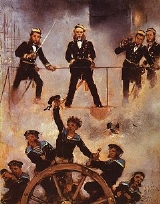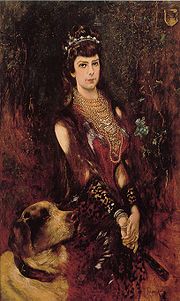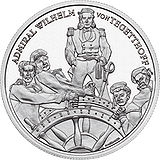
Anton Romako
Encyclopedia



Life
Anton Romako was born in AtzgersdorfAtzgersdorf
Atzgersdorf is a former municipality in Lower Austria that is now a part of the 23rd Viennese district Liesing. A small part of the former municipality today is part of the 12th Viennese district Meidling....
(now a district of Liesing
Liesing
Liesing is the 23rd district of Vienna . It is on the southwest edge of Vienna, Austria.It was formed after Austria's Anschluss with Germany, when Vienna expanded from 21 districts to 26...
, Vienna
Vienna
Vienna is the capital and largest city of the Republic of Austria and one of the nine states of Austria. Vienna is Austria's primary city, with a population of about 1.723 million , and is by far the largest city in Austria, as well as its cultural, economic, and political centre...
), as an illegitimate son of factory owner Josef Lepper and his housemaid Elisabeth Maria Anna Romako. He studied painting at the Academy of Fine Arts Vienna
Academy of Fine Arts Vienna
The Academy of Fine Arts Vienna is an institution of higher education in Vienna, Austria.- History :The Academy of Fine Arts Vienna was founded in 1692 as a private academy by the court-painter Peter Strudl, who became the Praefectus Academiae Nostrae. In 1701 he was ennobled as Baron of the Empire...
(1847–49) but his teacher, Ferdinand Georg Waldmüller
Ferdinand Georg Waldmüller
Ferdinand Georg Waldmüller was an Austrian painter and writer.He briefly attended the Academy of Fine Arts Vienna, but later had to finance his life by painting portraits. In 1811 he worked as a teacher of arts for the children of Count Gyulay in Croatia...
, considered him talentless. Later, he studied in Munich
Munich
Munich The city's motto is "" . Before 2006, it was "Weltstadt mit Herz" . Its native name, , is derived from the Old High German Munichen, meaning "by the monks' place". The city's name derives from the monks of the Benedictine order who founded the city; hence the monk depicted on the city's coat...
(1849) under Wilhelm Kaulbach, and subsequently in Venice
Venice
Venice is a city in northern Italy which is renowned for the beauty of its setting, its architecture and its artworks. It is the capital of the Veneto region...
, Rome
Rome
Rome is the capital of Italy and the country's largest and most populated city and comune, with over 2.7 million residents in . The city is located in the central-western portion of the Italian Peninsula, on the Tiber River within the Lazio region of Italy.Rome's history spans two and a half...
and London
London
London is the capital city of :England and the :United Kingdom, the largest metropolitan area in the United Kingdom, and the largest urban zone in the European Union by most measures. Located on the River Thames, London has been a major settlement for two millennia, its history going back to its...
. In the early 1850s he studied privately in Vienna under Carl Rahl
Carl Rahl
Carl Rahl, sometimes spelled Karl Rahl , was an Austrian painter.Rahl was born in Vienna to Carl Heinrich Rahl , an engraver. He attended the Academy of Fine Arts Vienna and won a prize at the age of 19. From there he traveled to Munich, Stuttgart, Hungary, and in 1836 to Italy...
, whose style Romako adopted. In 1854 he began travels to Italy and Spain and in 1857 settled in Rome as the favourite portrait
Portrait
thumb|250px|right|Portrait of [[Thomas Jefferson]] by [[Rembrandt Peale]], 1805. [[New-York Historical Society]].A portrait is a painting, photograph, sculpture, or other artistic representation of a person, in which the face and its expression is predominant. The intent is to display the likeness,...
, genre, and landscape
Landscape art
Landscape art is a term that covers the depiction of natural scenery such as mountains, valleys, trees, rivers, and forests, and especially art where the main subject is a wide view, with its elements arranged into a coherent composition. In other works landscape backgrounds for figures can still...
painter for the local colony of foreigners.
In 1862 Romako married Sophie Köbel, the daughter of architect Karl Köbel, and the pair had five children before Sophie left Romako in 1875 for her lover. In 1876 Romako returned to Vienna but failed to re-establish himself against the style representend by Hans Makart
Hans Makart
Hans Makart was a 19th century Austrian academic history painter, designer, and decorator; most well known for his influence on Gustav Klimt and other Austrian artists, but in his own era considered an important artist himself and was a celebrity figure in the high culture of Vienna, attended with...
and increasingly relied on the charity of such wealthy patrons as Count Kuefstein. He made study trips to Hungary, Italy and France, and during the years 1882-84 he alternated between Paris
Paris
Paris is the capital and largest city in France, situated on the river Seine, in northern France, at the heart of the Île-de-France region...
and Geneva
Geneva
Geneva In the national languages of Switzerland the city is known as Genf , Ginevra and Genevra is the second-most-populous city in Switzerland and is the most populous city of Romandie, the French-speaking part of Switzerland...
. Two daughters, Mathilde and Mary, committed suicide in 1887; Romako had never recovered from the shock. His last years were spent living in neglect near Vienna, where he died in poverty in 1889. Romako was buried at the Central cemetery in Vienna
Zentralfriedhof
The Zentralfriedhof is one of the largest cemeteries in the world, largest by number of interred in Europe and most famous cemetery among Vienna's nearly 50 cemeteries.-Name and location:...
.
In 1953 a street in Atzgersdorf was named after the painter: Romakogasse. Anton Romako's painting "The battle of Lissa" was selected as a motive for a recent commemorative coin: the 20 euro S.M.S. Erzherzog Ferdinand Max minted on September 15, 2004.
His brother, Joseph von Romako, was a Naval Architect-Inspector of Austro-Hungarian Navy
Austro-Hungarian Navy
The Austro-Hungarian Navy was the naval force of Austria-Hungary. Its official name in German was Kaiserliche und Königliche Kriegsmarine , abbreviated as k.u.k. Kriegsmarine....
.
Works
Romako painted a large number of landscape scenes (for example from the Bad GasteinBad Gastein
Bad Gastein is a spa town in the Austrian state of Salzburg, situated at the northern rim of the Hohe Tauern national park. It has 5,838 inhabitants. The name "Bad" means "spa", reflecting the town's history as a health resort. It is located at the head of the Gastein valley, about 1,000 metres ...
), influenced by the Barbizon school
Barbizon school
The Barbizon school of painters were part of a movement towards realism in art, which arose in the context of the dominant Romantic Movement of the time. The Barbizon school was active roughly from 1830 through 1870...
, but is known mostly for his portraits and historical scenes. His early works display the influence of Biedermeier
Biedermeier
In Central Europe, the Biedermeier era refers to the middle-class sensibilities of the historical period between 1815, the year of the Congress of Vienna at the end of the Napoleonic Wars, and 1848, the year of the European revolutions...
realism, while the late works are painted in a nervous expressionist
Expressionism
Expressionism was a modernist movement, initially in poetry and painting, originating in Germany at the beginning of the 20th century. Its typical trait is to present the world solely from a subjective perspective, distorting it radically for emotional effect in order to evoke moods or ideas...
style which disturbed his contemporaries. More than a decade passed before his works were reconsidered and appreciated.
Nowadays Romako is seen as one of the most interesting and trailblazing artists of the "Ringstraßenepoche" era. He was impressed by the young Oscar Kokoschka and had a great influence on his work. Many paintings of Anton Romako are shown in the Belvedere gallery
Österreichische Galerie Belvedere
The Österreichische Galerie Belvedere is a museum housed in the Belvedere palace, in Vienna, Austria.The art collection includes masterpieces from the Middle Ages and Baroque until the 21st century, though it focuses on Austrian painters from the Fin de Siècle and Art Nouveau period...
in Vienna.
His famous portrait of empress Elisabeth
Elisabeth of Bavaria
Elisabeth of Austria was the spouse of Franz Joseph I, and therefore both Empress of Austria and Queen of Hungary. She also held the titles of Queen of Bohemia and Croatia, among others...
, showing her eccentric personality, was generally rejected at the time. The most known work, the portrait of Admiral Wilhelm von Tegetthoff
Wilhelm von Tegetthoff
Wilhelm von Tegetthoff was an Austrian admiral. Considered one of the prominent naval commanders of the 19th century, Tegetthoff was known for his innovative tactics as well as his inspirational leadership....
during the naval Battle of Lissa
Battle of Lissa (1866)
The Battle of Lissa took place on 20 July 1866 in the Adriatic Sea near the Dalmatian island of Lissa and was a decisive victory for an outnumbered Austrian Empire force over a superior Italian force...
, shows the admiral and a few sailors without the usual heroism at the moment when his ship 'Ferdinand Max' is going to ram an Italian flagship.
- Die Eitelkeit - Porträt seiner Brau Sophie Köbel (Salzburg, Residenzgalerie), around 1860, oil on canvas, 124 x 91 cm
- Fischerknabe am Meeresstrand (Fisherboy at seashore) (Wien, Österreichische Galerie), around 1873-75, oil on wood, 90 x 70 cm
- Mädchen mit Kaninchen (Girl with a rabbit) (St. Pölten, Niederösterreichisches Landesmuseum), about 1877, oil on canvas, 72,7 x 60,6 cm
- Admiral Tegethoff in der Seeschlacht bei Lissa (Admiral TegethoffWilhelm von TegetthoffWilhelm von Tegetthoff was an Austrian admiral. Considered one of the prominent naval commanders of the 19th century, Tegetthoff was known for his innovative tactics as well as his inspirational leadership....
at the 1866 naval battle of LissaBattle of Lissa (1866)The Battle of Lissa took place on 20 July 1866 in the Adriatic Sea near the Dalmatian island of Lissa and was a decisive victory for an outnumbered Austrian Empire force over a superior Italian force...
) (Wien, Österreichische Galerie), 1878–80, oil on wood, 110 x 82 cm - Am Wasserfall (At the waterfall) (Wien, Leopold Museum), 1881, oil on canvas, 89,3 x 63 cm
- Kaiserin Elisabeth (Empress ElisabethElisabeth of BavariaElisabeth of Austria was the spouse of Franz Joseph I, and therefore both Empress of Austria and Queen of Hungary. She also held the titles of Queen of Bohemia and Croatia, among others...
) (Wien, Österreichische Galerie), 1883 - Die Rosenpflückerin (Wien, Österreichische Galerie), 1883, oil on canvas, 89 x 66 cm
- Mutter und Kind (private collection), 1883, oil on canvas, 161 x 130 cm
- Junge Frau vor Bildstock (private collection), 1883, oil on wood, 54,4 x 45,5 cm
- Südfranzösische/Bretonische Bäuerin (Graz, Landesmuseum Joanneum), 1884, oil on canvas, 50,5 x 38,5 cm
- Mädchen, einen Fink anlockend (St. Pölten, Niederösterreichisches Landesmuseum), around 1884/85, oil on wood, 45,2 x 28 cm
- Bildnis Isabella Reisser (Wien, Leopold Museum), 1885, oil on canvas, 130,5 x 90 cm
- Herr und Dame im Salon (Museen der Stadt Wien), 1887, oil on wood
- Dame in rotem Kleid (Wien, Österreichische Galerie), 1889, oil on canvas
"Portrait of August Wassermann"(Budapest,Museum of Fine Arts)

